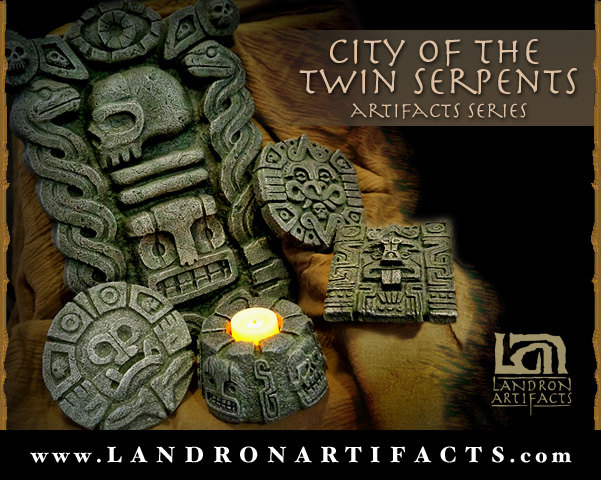Ultimate Mars Challenge
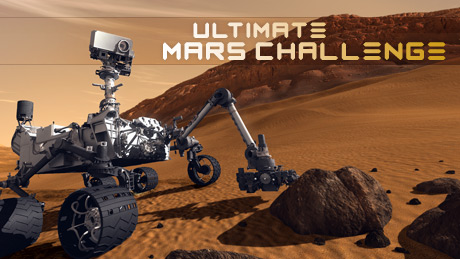
Introduction – The First Time For Everything
For the first time in my life I’m asked to do a review of a motion picture or television program with a brand new perspective – not as a movie fan, or historian, or commentator. Not even as just an amateur astronomer, but this time as a geology student. For the past couple of months I’ve been on a brand new adventure looking deeper into the realm of a branch of science I didn’t know I would be interested in, for so long I’ve been more interested in the skies above than what’s been going on beneath my feet. There was a specific moment while studing this topic that I began to realize it’s importance, in knowing how the earth formed while knowing that the laws of physics and chemistry must be the same everywhere we can have a better understanding of how other terrestrial type worlds may be formed elsewhere.
With this revelation (an obvious one I’ve had many times before) that geology and astronomy must meet somewhere, my interest in “what’s out there” has been renewed. I’m asking now with a renewed perspective; what’s really out there? What worlds await us out for us if we (as a species) can ever get our acts together and cooperate in fulfilling our goals?
For these reasons, and this class in particular thanks to new knowedge about geology and a better understanding of what NASA and JPL are looking at via the Mars Rovers, this is perhaps one of the most exciting documentaries I’ve watched in recent memory.
Part 1 – Building Curiosity
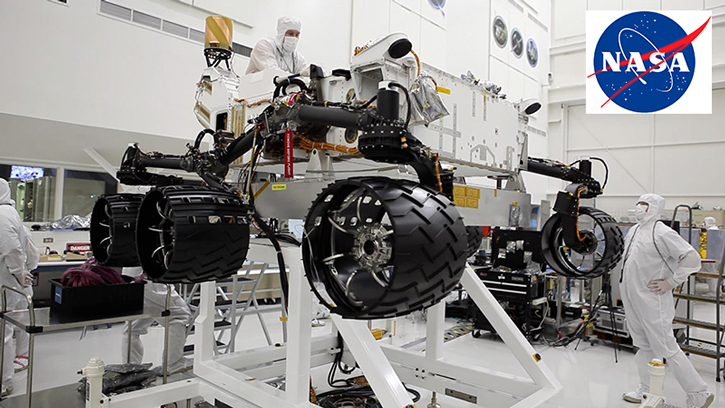
This NOVA special begins with the dramatic fashion of showing us a flashback of the landing of the Mars Curiosity rover, a preview of its design and being built. We’re enticed to see the pictures that the rover eventually took later on it’s mission while we’re subjected to the stress at the rover’s mission control and told time and again that this is a difficult task to accomplish thanks to histrionics from the narrator; “The moment of truth is fast approaching for several hundred engineers and scientists at the Jet Propulsion Laboratory, in southern California. Eight months ago, this team launched a mission to Mars. In less than an hour, the spacecraft they designed and built will touch down safely or meet an inglorious end.”
It’s hard to get excited about an event that already happened as if it hasn’t, we all knew what happened to “Titanic” and “Apollo 13” It’s the human drama behind those scenes even when we know the outcome… we knew what happened to ‘the ship God himself couldn’t sink,’ but thanks to movie magic we are made to want to know what happened to specific characters like some of the passengers and ship’s crew.
While this is supposed to be about the science of the Mars and the geology science they’re out to accomplish, this NOVA special gets us to know and care about the people behind the program and participated in creating it before sending it on it’s way with emotions not unlike a parent dropping off a child off at school for the first time. This special isn’t a golorified commercial about the engineering acompishments of NASA and JPL but it’s a story about real people and their attempt to tackle a near impossible task to answers the fundamental question; why explore the geology of Mars? The exploration of Mars is the search for life outside our own planet and answers the age old question…
JOHN GROTZINGER (Chief Scientist, Mars Science Laboratory): Are we alone? I think it's the grandest of all scientific questions.
ADAM STELTZNER (Entry Descent and Landing Lead, Mars Science Laboratory): We go exploring, because we are curious creatures, human beings.
JAIME WAYDO (Mobility Lead, Mars Science Laboratory): We want to discover the unknown. Going to Mars is like the new frontier.
ROB MANNING (Chief Engineer, Mars Science Laboratory): This will be the most exciting adventure we've ever undertaken on Mars.
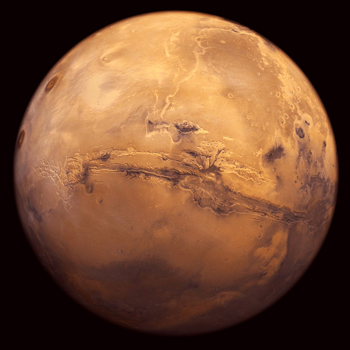 The narrator expounds upon this; “What keeps drawing us back to the Red Planet? Mars may be only half the size of Earth, but it has grandeur: the largest known canyon in our solar system slices across its equator, roughly 10 times longer and three times deeper than the Grand Canyon on Earth; the tallest volcano in the solar system rises 16 miles above the Martian plain; colossal craters punctuate the planet—beautiful, but there's nothing welcoming about this place.”
The narrator expounds upon this; “What keeps drawing us back to the Red Planet? Mars may be only half the size of Earth, but it has grandeur: the largest known canyon in our solar system slices across its equator, roughly 10 times longer and three times deeper than the Grand Canyon on Earth; the tallest volcano in the solar system rises 16 miles above the Martian plain; colossal craters punctuate the planet—beautiful, but there's nothing welcoming about this place.”
As I hoped to explore in another section of this site, I want to explain that it’s more than just that. For ages we have looked at Mars and wondered what was out there as it became the catch-all word for things that were not of this earth. The word “Martian” was synonymous with words “alien” and “extraterrestrial.” Since we’ve been able to look at Mars through telescopes it’s been our ceaseless desire to explore that new world with the same instinctive desire we had to explore the new hemisphere rediscovered by the trans-oceanic explorers of the fourteen and fifteen hundreds and many more who followed them.
As a child I have wondered who is going to be the “Neil Armstrong, Buzz Aldrin and Michael Collins” of Mars in the next few decades. To wonder about the Martian world and what waits for us there is a part of the essence of being human, the curiosity of what’s beyond the next threshold is as much of our lives as our heart beating.
In our current age, the exploration of Mars is the search for extraterrestrial life.
JOHN GROTZINGER: Most experts would agree that, three-and-a-half- to four billion years ago, on Mars, there was probably significantly more water, in lakes, as flowing rivers at times. To some extent, Mars is like a twin of Earth, early in its history.
NARRATOR: Back when Mars was awash with water, did life take hold there? What transformed the planet into a frozen wasteland? Could there be life on Mars today? These are the questions that lead us back to the Red Planet time and again.
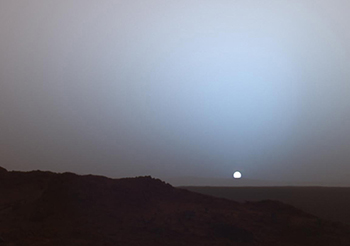 The specific reasons why Curiosity was sent to Mars was to look for three specific things; the same things that are essential for life on Earth; a heat source such as power from the sun or underground volcanic activity, liquid water, and organic compounds that are necessary for “the building-blocks of life.” To further elaborate, they’re looking for specific minerals that are necessary to create amino acids and a food source for such primitive life like bacteria that might still exist there.
The specific reasons why Curiosity was sent to Mars was to look for three specific things; the same things that are essential for life on Earth; a heat source such as power from the sun or underground volcanic activity, liquid water, and organic compounds that are necessary for “the building-blocks of life.” To further elaborate, they’re looking for specific minerals that are necessary to create amino acids and a food source for such primitive life like bacteria that might still exist there.
John Grotzinger takes us out into the desert to demonstrate what kinds of things The Curiosity Rover has been doing on the Martian surface since it’s landing with allegory examples of what he carries in his field bag compared to what our robot has in its arsenal of equipment.
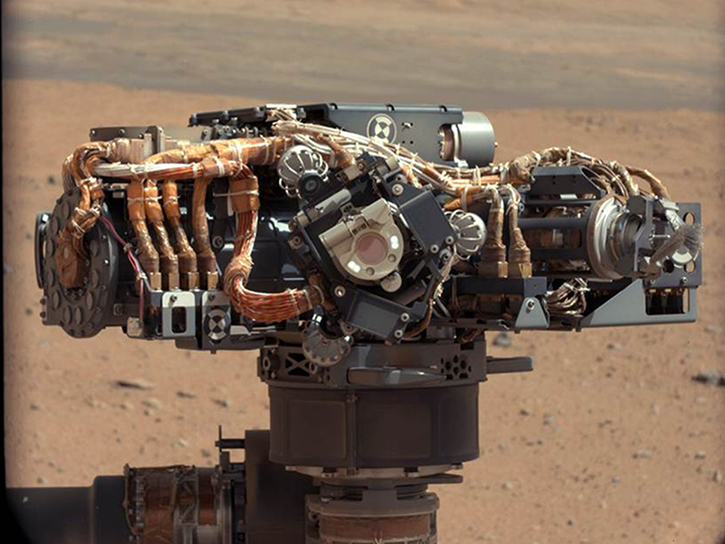
“When a geologist looks at a landscape like this, on Earth, we're looking for a way to unravel what the early environmental history of the planet was. Now, on Mars, with Curiosity, we can do the same thing.
In this scene we’re introduced to the The Mars Hand Lens Imager, or MAHLI, which can view rocks up close or from afar.
We’re also introduced to other capabilities of the other instruments on Curiosity…
NARRATOR: Curiosity has more advanced techniques for tackling rock, like a laser that can vaporize a spot the size of a pinhead up to 25 feet away. A flash of colored light is released, revealing the rock's chemical composition. The rover also has a drill that pulverizes rock and collects the resulting powder.
JOHN GROTZINGER: On Earth, we'd have to take the piece that we broke back to the lab, to do the analysis there. With Curiosity, we bring the lab to the field.
NARRATOR: The rover's robotic arm feeds powdered rock and soil to two miniaturized laboratories inside the rover. One lab uses x-ray beams to identify minerals, the other tests for the presence of organic molecules that may have been associated with life.
JOHN GROTZINGER: What's important about organic molecules is that you don't have to have an actual fossil of an organism left behind, in order to detect the former presence of life. So, we're not doing life detection, but we can look for these organic compounds.
This NOVA special is only an hour long and glosses over too many of the equipment packages onboard Curiosity, to read more about them please visit this portion of the NASA website – Science Instrument Details with other pages devoted to the cameras, spectrometers, Radiation Detectors, Environmental and Atmospheric censors.
The two instruments that this documentary glosses over are the Chemistry & Camera (ChemCam) and Chemistry & Mineralogy X-Ray Diffraction (CheMin) devices.
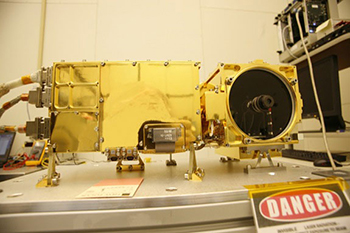 Chemistry & Camera (ChemCam) device is the one shown that uses a laser to burn away a small circular spot of it’s target rock and analyzes the colored smoke that’s released. The on-board spectrograph camera has the ability to gage what that rock is made of via the colors in the released gasses and is able to decipher it’s elements, minerals and possible traces of water and organic materials that were trapped inside.
Chemistry & Camera (ChemCam) device is the one shown that uses a laser to burn away a small circular spot of it’s target rock and analyzes the colored smoke that’s released. The on-board spectrograph camera has the ability to gage what that rock is made of via the colors in the released gasses and is able to decipher it’s elements, minerals and possible traces of water and organic materials that were trapped inside.
Here’s the synopsis of the devices capabilities further detailed via the NASA webpage.
From 23 feet (7 meters) away, ChemCam will be able to:
- rapidly identify the kind of rock being studied (for example, whether it is volcanic or sedimentary);
- determine the composition of soils and pebbles;
- measure the abundance of all chemical elements, including trace elements and those that might be hazardous to humans;
- recognize ice and minerals with water molecules in their crystal structures;
- measure the depth and composition of weathering rinds on rocks; and,
- provide visual assistance during drilling of rock cores.
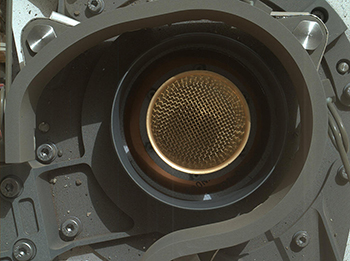 Chemistry & Mineralogy X-Ray Diffraction (CheMin) devices. is the one that was shown with the drilling sample that was poured into a sifter that wasn’t too dissimilar to a coffee maker. The goal of this device is the same as ChemCam, but it takes the samples physically and analyzes them directly view them via an x-ray emitter and receiver.
Chemistry & Mineralogy X-Ray Diffraction (CheMin) devices. is the one that was shown with the drilling sample that was poured into a sifter that wasn’t too dissimilar to a coffee maker. The goal of this device is the same as ChemCam, but it takes the samples physically and analyzes them directly view them via an x-ray emitter and receiver.
Using CheMin, scientists will be able to study further the role that water, an essential ingredient for life as we know it, played in forming minerals on Mars. For example, gypsum is a mineral that contains calcium, sulfur, and water. Anhydrite is a calcium and sulfur mineral with no water in its crystal structure. CheMin will be able to distinguish the two. Different minerals are linked to certain kinds of environments. Scientists will use CheMin to search for mineral clues indicative of a past Martian environment that might have supported life.
These two project packages are exactly what geologists need to explore the surface of Mars to better understand it’s composition and the way it was formed.
For the next five or ten minutes the NOVA special spends considerable time explaining the landing technology that involved more physics and aerodynamics then actual geometry that we’ll skip for our purposes for this section and hope to explore later.
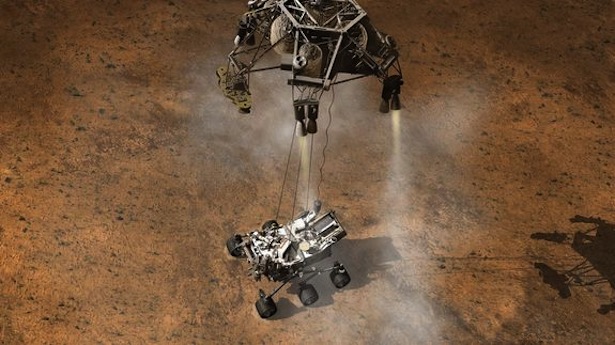
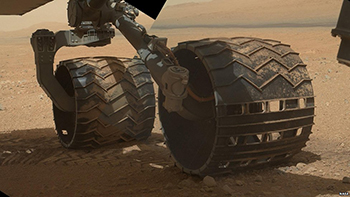 While exploring the building of Curiosity we spend considerable time with Jaime Waydo who was the Mars Science Laboratory Lead Mobility Mechanical Engineer, “Responsible for all technical aspects of the rover mechanical deliverable and worked all system engineering decisions and trades within the rover mechanical area.1”
While exploring the building of Curiosity we spend considerable time with Jaime Waydo who was the Mars Science Laboratory Lead Mobility Mechanical Engineer, “Responsible for all technical aspects of the rover mechanical deliverable and worked all system engineering decisions and trades within the rover mechanical area.1”
She gives a great insight into the robotics of this incredible machine and many of it’s components, specifically the landing gear and why it was built and designed for it’s specific tasks, to traverse the harsh typography of the Martian surface safely and autonomously since it’s alone and millions of miles away from any AAA service. The wheels and it’s suspension have to be built in such a way to handle the extreme cold temperatures and terrain after serving as the rovers landing gear that would protect the science packages onboard from shock.
JAIME WAYDO: The rover touches down at almost three feet a second, which doesn't sound that fast, but some of those loads are 2,500 pounds, going into each individual wheel. And what the wheels don't absorb goes into the suspension. We're just trying to make sure that all of those precious science instruments are safe.
If you look at the modern bicycle, they do amazing things with shaping the tubes of the bicycle frame, for the stiffnesses they want, in every direction. And so, we talked to a bicycle company that makes titanium bikes, and they helped us build the suspension tubes.
We ended up taking a bicycle wheel and making it as strong as possible and taking that to the extreme and making it, basically, a Martian bicycle wheel.
The final special design of Curiosity’s wheel consisted of a deep, wide wheel of pliable aluminum with an internal structure of curved titanium spokes that’s specifically shaped to handle solid rocky terrain and soft sand dunes.
Deploying the landing gear/suspension system and wheels took small explosions that released the holding pins that kept everything neatly folded within the spacecraft during the journey from Earth to Mars. They tested these systems over various different types of terrain they suspected the rover might encounter during landing.
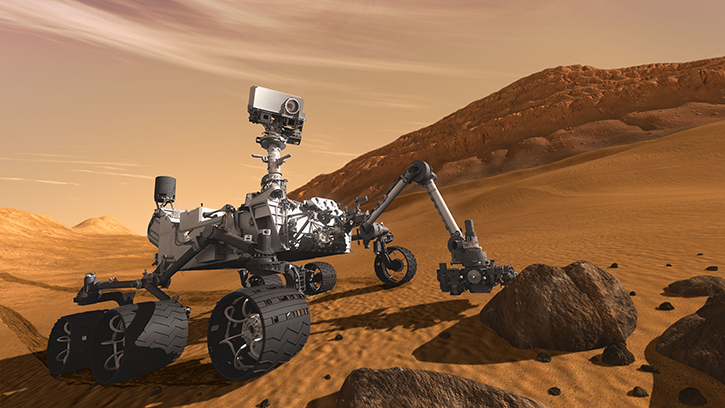
Part 2 –What Curiosity Found
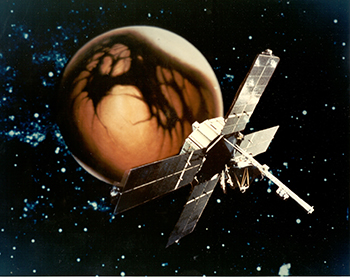 Before this NOVA special divulged into the results of Curiosities findings we were indulged into a trip down memory lane via past explorations. We enjoyed looking at the earliest views of Mars up-close via cameras on Mariner 4, and Mariner 9 from the 1960’s. Eventually we saw the triumphant Viking program which deployed two different landers on opposite sides of Mars. The lack of any conclusive signs of life – even microscopic – was responsible for the lack of Martian exploration for more than 10 years.
Before this NOVA special divulged into the results of Curiosities findings we were indulged into a trip down memory lane via past explorations. We enjoyed looking at the earliest views of Mars up-close via cameras on Mariner 4, and Mariner 9 from the 1960’s. Eventually we saw the triumphant Viking program which deployed two different landers on opposite sides of Mars. The lack of any conclusive signs of life – even microscopic – was responsible for the lack of Martian exploration for more than 10 years.
Eventually during that reprieve while we looked at the pictures sent back from those programs scientists began to ask; what happened to the water? More to point, if we follow the visual evidence of what appears to be dried up rivers, deltas, and even canals then it should be safe to presume there was once water on Mars. Is there any evidence water still locked beneath the surface of the Martian dirt? If it wasn’t water than what else could it be, lava?
NARRATOR: When we returned to Mars, we pursued a different line of reasoning: if Mars ever had life as we know it, it would have needed liquid water. Those channels and valleys looked like they'd been carved by water, but what if some other force, like lava flows had created them? NASA's exploration strategy became "follow the water." A new generation of orbiters began to scour the Martian surface.
PHIL CHRISTENSEN (Arizona State University): The beauty of orbit is you can send a lot of instruments. These orbiters are pretty big. We've flown cameras that can actually measure the temperature of the surface, lasers that can measure the height of the mountains, and spectrometers that can map what minerals are present. So, from orbit, we can map the entire planet and figure out where all the goodies are.
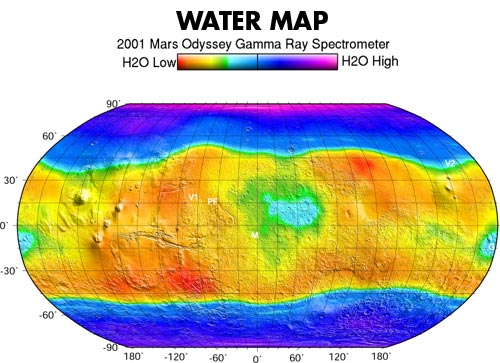
Thanks to the many orbiting probes around Mars, we did research from space to look for the ideal conditions to look for this underground water.
Thanks to the Martian Obiters that were searching for elements from space we found some specific regions that had evidence of water and one of those locations where they found evidence was where The Opportunity Lander touched down and found tiny spheres on the surface of the ground and in sedimentary rock. What they found was hematite that was created among the rock in dense saline.
STEVE SQUYRES (Cornell University): The fact that these rocks are layered says that one possible origin for these is that they were laid down in liquid water. And we have, on our rover, a toolkit of gizmos that will tell us that answer…
We think we're parked on what was once the shore of a salty sea on Mars. That's pretty cool.
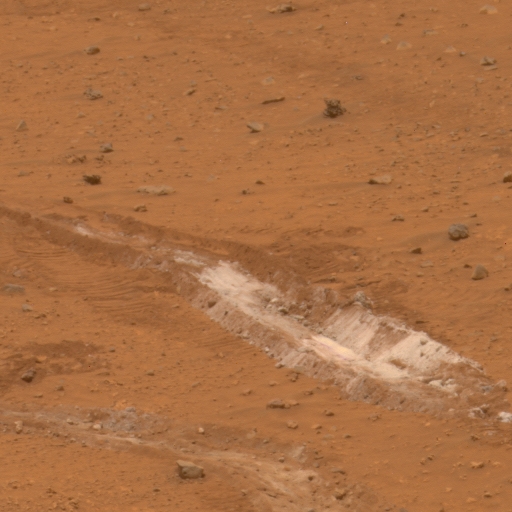
As Opportunity was accomplishing it’s tasks, it’s twin Spirit explored soil with huge deposits of silica that most likely formed from Martian hot springs. Similar to Opportunity and Spirit, the lander Phoenix landed on the Martian north pole and trowelled the surface and found large icy blue masses just under the surface. When the warmer months came to that region Phoenix watched the icy blue mass evaporate under the sun, proving that it was either traditional water ice or possibly frozen carbon dioxide.
Various other searches have yielded other results with strong evidence of Martian water in the form of underground streams and lakes or seas that have long-ago dried up.
NARRATOR: In days, the clumps vaporized. It was water ice. Mars has enough near-surface water ice that, melted, it would cover the planet in a sea, at least 30 feet deep. There are even hints that liquid water may appear, fleetingly, on Mars today. In the southern hemisphere, in spring, dark streaks appear in steep gullies and extend downhill, then fade away in the fall. Some scientists believe the streaks may be caused by salty water flowing just beneath the surface.
PHIL CHRISTENSEN: This big picture orbital view really has just revolutionized how we think about Mars. There are incredible mineral deposits, rocks that formed in lakes and hot springs. We even think there might be water that's flowing in little channels today.
Using other instrements like our own telescopes here on Earth we’ve found traces of methane gas which seems to be seasonal; it’s there for some time than is gone in later observations. The source of this geological activity could be attributed to ground quakes or small volcanoes but we haven’t seen any geological activity that leads us to believe the planet is solid down to the core.
Another possibility is microscopic organism who behave the same way they do here on Earth, thrive during the warmer months and hibernated during the colder periods.
It’s this moment in the documentary when we continue to explore more of Curiosity’s capabilities; specifically the robotic arm…
BRANDON METZ: The robotic arm is extremely complex, because we have five joints. We have what we call the azimuth joint, which is really just kind of…you can think of your shoulder moving back and forth. Then we have elevation, which, again, is like your shoulder moving up and down. And then we have the elbow, which actually works like the elbow; it usually moves like that. And then we have wrist, which is just, kind of, like the wrist: it moves it about here. And then we have turret, which allows us to, like, rotate 360, you know, in either direction. So, so the robotic arm it is really an engineering masterpiece.
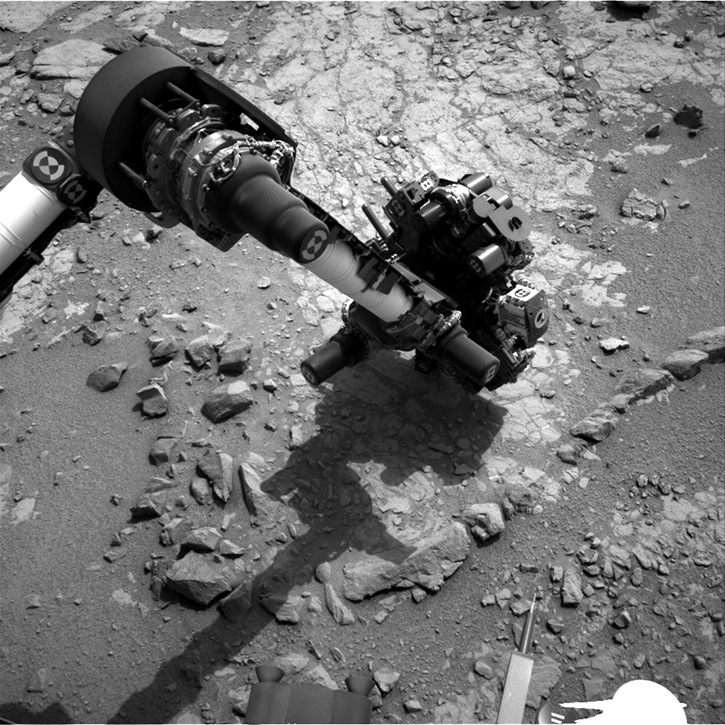
We are introduced to other tools on Curiosy’s “hand” beyond Alpha Particle X-ray Spectrometer (APXS) and the Mars Hand Lens Imager (MAHLI). We’re shown the advanced drilling tools which are responsible for getting more samples of rock from the Martian surface. The advanced drills are built to handle the challenges of an alien enviorment and the delicacy or fragility of the other science packages elsewhere on the rover. It’s built to be rugged and handle the extreme vibrations of the drill and the shaking of the sifting mechanism.
The mechanism is also developed to jettison the drill bit if it gets stuck and simple replace it with another via the built-in revolver with multiple spares.
Moving to the actual location of the landing sight we see much of the debate that went into it’s choosing. They looked for the ultimate geological location that had interesting things to see, explore and sample, this needed to be a region that would be like a shore of a vintage water body that hand many of the elements we discussed before, evidence of water and salts.
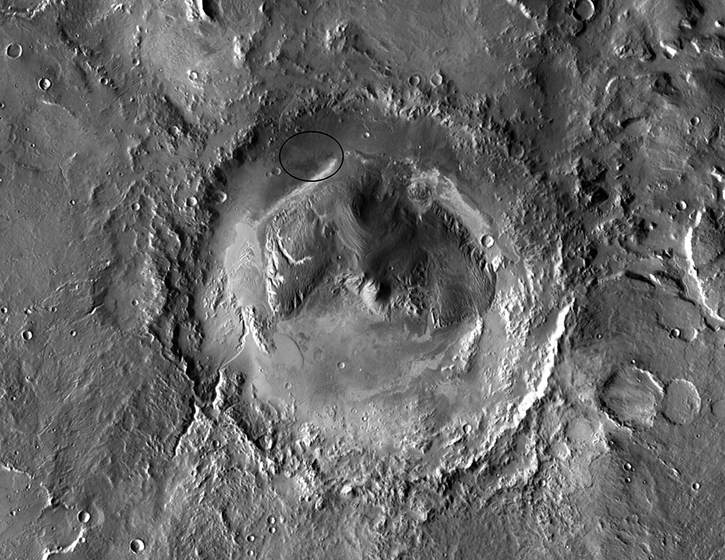
The location they picked was Gale Crater because of the evidence of flowing water into this meteor impact site with a visible pattern that looks like a incised channel or delta. This is also at the base of Mount Sharp where water may have flowed down and might have carved out evidence of layers that could display millions of years of Martian geology.
PHIL CHRISTENSEN: And you know, geologists, their eyes light up when they see layered rocks, because that's the storybook.
JOHN GROTZINGER: Exploring Mount Sharp, we start at the bottom, and we go to the top. We drive up through the layers, and we turn through the pages and chapters, and we may not finish the book, but I'm sure it's going to be a good read.
One of the first bits of scientific exploration it did was look at the landing jets scour marks where the soil was blasted away and revealed sedimentary material that looked like it was composed of rocks that were cemented together with mud made from local dirt and water which has long since vanished.
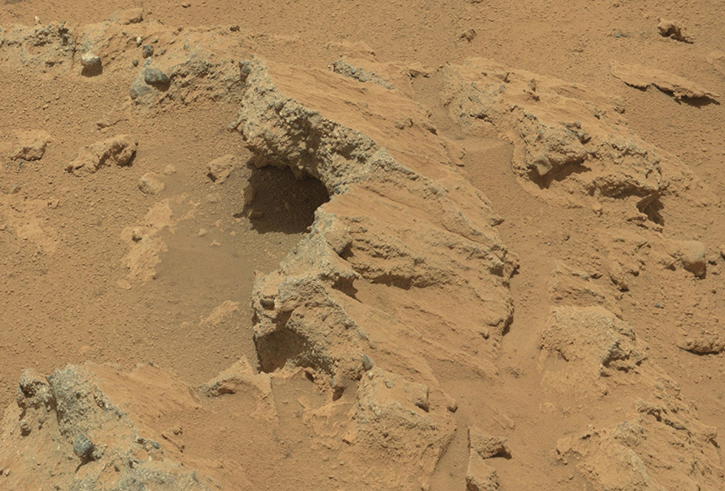
As part of the mission fan, Curiosity went to explore the aforementioned water formations that were created there in the crater and the alluvial fan type delta. From there we saw evidence of a great upheaval that could have only been created by a flood, a massive torent of water removed an outcrop of sendematary rock.
JOHN GROTZINGER: You're like, "My goodness, it looks like somebody got a jackhammer up and lifted up a piece of the sidewalk in New York City." And when you look at the slab, end on, you see pebbles in it. They seem to have rounded edges; they've all been smoothed off a little bit. And so, what that brings to mind immediately is what you see in a, in a riverbed. As the water pushes the pebbles along, they collide with each other, and they progressively get rounder.
By looking at the rocks in the hardened sedimentary layers we see rocks that were rounded smooth, evidence that they were once at the bottom of a river rapid, evidence of free flowing water on the Martian surface.
As Curiosity continues to travel to its next destination to the remains of Mount Sharp, it found what may have been volcanic soil and mineral deposits.
As of the end this documentary, we’re reassured that Curiosity’s mission is far from over.
Part 3 – The Future Curiosity
For those of us who want to continue to explore along with Curiosity, I highly recommend the website that’s a joint venture with NASA/JPL and the USGS: NASA Mars Rover Curiosity: Mission Updates.
With many updates we’re able to read detailed information on the latest discoveries, the latest from December 10th, 2014 and a detailed analysis of Whale Rock. What we’re told is that this is an example of a phenomenon that we’ve originally viewed here on Earth, we’re presented rock that’s displaying cross-bending thanks to water passing over this sediment bed.
What’s most exciting about this site is the consistent stream of information which includes high resolution pictures and a PDF of the data that’s been recovered for fellow scientists to share and import into their own research for future discoveries outside NASA, JPL and USGS.
Another exiting site is USGA’s own site that has a comprehensive database of other worlds and their geology in our own solar system. One of the most exciting sections is devoted to the genolgy of Saturn’s moon, Titan, and discovery of a volcano.
Links
Jaime Waydo’s Linkedin profile.
USGS Astrogeology Science Center
NASA/JPL "Silica on a Mars Volcano Tells of Wet and Cozy Past."
NASA: "Mars Rover Spirit Unearths Surprise Evidence of Wetter Past"
NASA: "Rock Outcrops on Mars and Earth"
Space.com "1st Drilling on Mars by NASA's Curiosity Rover," February 20, 2013 04:20pm ET
NASA Mars Rover Curiosity: Mission Updates.
Read "The Geological Features Of Mars"
Don't Forget to change the URL for the Facebook Widget!




